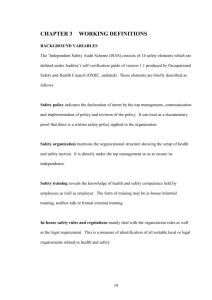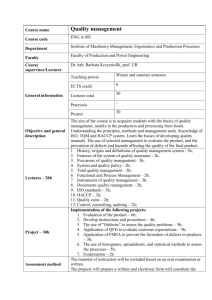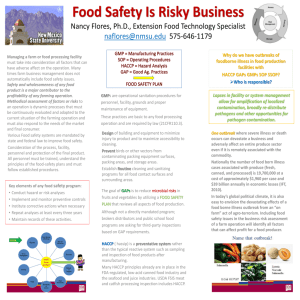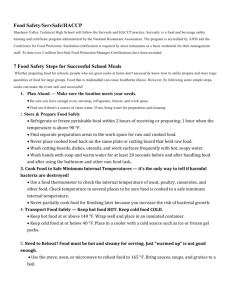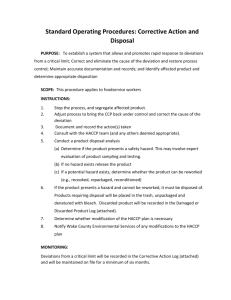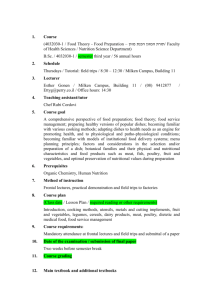M General Guidelines for Implementation of HACCP in a Poultry Processing Plant
advertisement
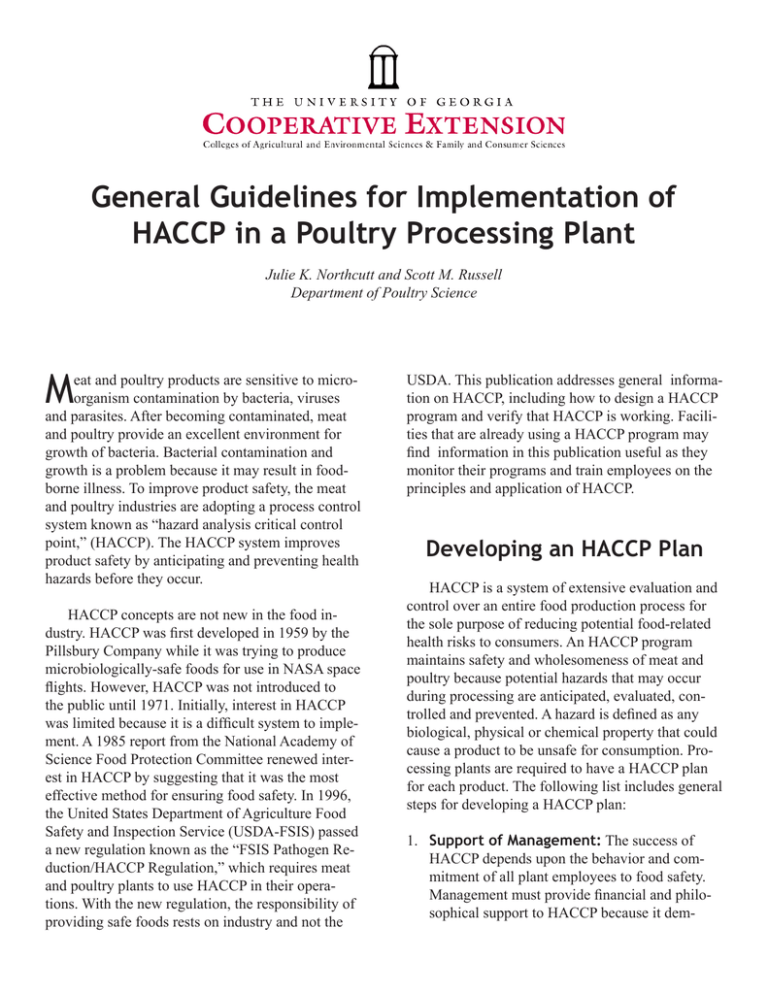
General Guidelines for Implementation of HACCP in a Poultry Processing Plant Julie K. Northcutt and Scott M. Russell Department of Poultry Science M eat and poultry products are sensitive to microorganism contamination by bacteria, viruses and parasites. After becoming contaminated, meat and poultry provide an excellent environment for growth of bacteria. Bacterial contamination and growth is a problem because it may result in foodborne illness. To improve product safety, the meat and poultry industries are adopting a process control system known as “hazard analysis critical control point,” (HACCP). The HACCP system improves product safety by anticipating and preventing health hazards before they occur. USDA. This publication addresses general information on HACCP, including how to design a HACCP program and verify that HACCP is working. Facilities that are already using a HACCP program may find information in this publication useful as they monitor their programs and train employees on the principles and application of HACCP. Developing an HACCP Plan HACCP is a system of extensive evaluation and control over an entire food production process for the sole purpose of reducing potential food-related health risks to consumers. An HACCP program maintains safety and wholesomeness of meat and poultry because potential hazards that may occur during processing are anticipated, evaluated, controlled and prevented. A hazard is defined as any biological, physical or chemical property that could cause a product to be unsafe for consumption. Processing plants are required to have a HACCP plan for each product. The following list includes general steps for developing a HACCP plan: HACCP concepts are not new in the food industry. HACCP was first developed in 1959 by the Pillsbury Company while it was trying to produce microbiologically-safe foods for use in NASA space flights. However, HACCP was not introduced to the public until 1971. Initially, interest in HACCP was limited because it is a difficult system to implement. A 1985 report from the National Academy of Science Food Protection Committee renewed interest in HACCP by suggesting that it was the most effective method for ensuring food safety. In 1996, the United States Department of Agriculture Food Safety and Inspection Service (USDA-FSIS) passed a new regulation known as the “FSIS Pathogen Reduction/HACCP Regulation,” which requires meat and poultry plants to use HACCP in their operations. With the new regulation, the responsibility of providing safe foods rests on industry and not the 1. Support of Management: The success of HACCP depends upon the behavior and commitment of all plant employees to food safety. Management must provide financial and philosophical support to HACCP because it dem1 onstrates an awareness of the benefits of the program. Employees will not take HACCP seriously if it does not receive visible support from their supervisors and upper management. principles of HACCP to design a plan. The basic principles of HACCP are listed in Table 1 and are briefly described below. 2. Establish a HACCP Team: HACCP is a program for the entire company; therefore, a team of individuals from different areas of production and processing should be involved in developing the HACCP plan. The team must include individuals with specific expertise, such as live production, grow-out, processing, quality control, sanitation, microbiology, plant engineering, and research and development. This should make it easier to identify the hazards associated with each products. A HACCP coordinator should be chosen to work with the HACCP team and company management to develop, implement and manage the HACCP plan. 3. Product Description: Plants are required to have a HACCP plan for each product they make. With each HACCP plan, a complete description of the product and the raw ingredients that go into the product are required. Some of the product description information that should be listed for each product includes: a. Product’s common name. b. How the product will be used. c. Type of packaging material. d. Length of product’s shelf-life, and at what temperature. e. Where product will be sold. f. Product’s labeling instructions. g. Any special instructions for the product. 4. Employee Training: All employees should be given HACCP training, but at levels relating to their responsibilities within the HACCP plan. Extensive training of line workers is critical because these are the individuals responsible for the product. Everyone at the facility in contact with the products should receive an overview of HACCP, as well as information regarding the companies HACCP policies and procedures. 5. Principles of HACCP and Implementation of a HACCP Plan: Once the HACCP team has been identified, the team should use the basic 2 Principle 1: Hazard Analysis. The first step in designing a HACCP plan is to conduct an analysis of hazards associated with each product. During hazard analysis, the HACCP team evaluates all of the procedures concerned with production, distribution, and the use of raw materials for potential problems that could occur. The HACCP team should list the type of problem (biological, chemical or physical), and the appropriate preventive action necessary to keep the problem from occurring. It may be useful to draw a flow diagram detailing production steps from live birds to the consumer and to present the hazard analyses in a table format (Table 2). Figure 1 shows an example of a typical flow diagram for raw poultry; however, diagrams should be developed to fit the unique conditions that exist in each plant. Once a flow diagram has been developed, it is important to check it to make sure that it is correct, and that steps have not been omitted. Principle 2: Identify CCP’s. The next and most important step is to determine the critical control points (CCP’s) in the process, or the points at which a loss of control could result in a biological, chemical or physical health hazard. CCP’s vary for different products, particularly if your facility processes raw and fully cooked poultry. In some cases, it may be difficult to decide if a processing step is a CCP. As a result, many companies will establish too many CCP’s. A CCP decision tree, such as the one shown in Figure 2, can be used to identify CCP’s. CCP’s should be noted on the flow diagram as part of the HACCP documentation. An example of a CCP for a fully cooked product is the cooking process because proper cooking eliminates pathogenic bacteria; however, after cooking, care should be taken to keep the product from being contaminated again. While proper cooking may be addressed in the plants standard operating procedures (SOP’s), it is also a CCP and should be listed as such. In raw products, pathogenic bacteria may be reduced and their growth controlled using a well designed HACCP plan, but elimination requires additional measures. Principle 3: Establish critical limits. Once the CCP’s have been determined, a critical limit or the amount of acceptable deviation has to be established for each CCP. Critical limits are set for product safety and not product quality. For example, the critical limit for frozen raw poultry storage and shipping would require the product be held below 41 degrees F, which does not constitute frozen but prevents bacterial growth. In a cooked product, an example of a critical limit would be that an internal temperature of the product reach at least 160 degrees F. Principle 4: Monitoring critical limits. All CCP’s must be monitored to insure that the process remains within critical limits. The HACCP team needs to establish methods not only for monitoring each CCP, but also for determining the frequency of CCP evaluation. Monitoring methods should be appropriate for online use and should provide a simple but rapid assessment. Visual observations, aroma, and measurements of temperature, pH, moisture, fat, etc. are commonly used to monitor poultry processing CCP’s. Traditionally, microbiological testing has not been used to monitor CCP’s because procedures are time consuming; however, with the advent of new rapid methods, microbiological testing could provide valuable information within minutes. Principle 5: Corrective action. In addition to monitoring CCP’s, procedures should be developed to describe what steps will be taken if the process goes out of control. The corrective action plan must include: 1) who is responsible for regaining control of the process, 2) how to regain control, 3) what to do with the product that was produced during the loss of control, and 4) how to handle a product recall. 3 Principle 6: Recordkeeping. Documentation of a formal HACCP plan for all products is required by USDA-FSIS. Detailed records must be kept of data recorded at CCP’s. Effective record keeping includes: ∙ List of HACCP team members and their responsibilities. ∙ Date all records. Identify all products and their intended use. ∙ HACCP flow diagrams with all CCP’s. ∙ List of all critical limits and preventive measures. ∙ Monitoring and verification plans. ∙ Course of action when a critical limit deviation occurs, and person(s) responsible for corrective actions. ∙ Procedures for product handling when deviation from critical limit occurs. ∙ Appropriate product packaging information and expected product shelf-life. ∙ HACCP check off sheets for each shift that must be signed upon completion of a step. ∙ HACCP plan reviews, date of reviews, and reviewer’s initials. ∙ Records of all deviations. Principle 7: HACCP Verification. Once established, each HACCP plan will change as the company adds new products, updates old products, installs new equipment, or changes product handling procedures. It is important to periodically verify that the HACCP plan is working. Verification procedures may include: ∙ Routine check of all HACCP plans and records. ∙ Routine check of monitoring procedures and equipment. ∙ Random microbiological sampling of all product contact surfaces, as well as a portion of the product. ∙ Official evaluation of product. ∙ Review of all critical limit deviations and product handling. Conclusion References HACCP was designed to prevent hazardous products from leaving the manufacturing or processing facility. The key to the success of HACCP is employee training, behavior and attitude. Some companies are under the misconception that they already have a HACCP plan because they are adequately controlling all areas where safety could be compromised. The difference is that, rather than monitoring isolated processing steps, an HACCP approach controls the entire production process as an integrated system. National Food Processors Association’s Microbiology and Food Safety Committee, 1993. Implementation of HACCP in a food processing plant. J. Food Prot. 56:548-554. Stevenson, K. E., and D. T. Bernard (ed.), 1995. HACCP - Establishing Hazard Analysis Critical Control Point Programs. The Food Processors Institute, Washington, D.C. Tompkin, R. B., 1990. The use of HACCP in the production of meat and poultry products. J. Food Prot. 53:795-803. Although HACCP provides insurance that poultry is safe, there is no way to completely eliminate all hazards. HACCP is most effective when used with other control systems. Total Quality Management programs and Standard Operating Procedures should be used along with HACCP to improve product safety, product quality, and plant productivity by providing intimate knowledge of the production process, production environment and processing equipment. 4 Table 1. Principles of HACCP as Defined by the National Advisory Committee on Microbiological Criteria for Foods Principle HACCP Steps 1 Conduct an analysis of the hazards in your plant. Make a list of all processing steps where a hazard might occur. 2 Identify all critical control points (CCP’s) in the process. CCP’s are critical to the safety of the product. 3 Establish a critical limit for each of the identified CCP’s. 4 Establish CCP monitoring requirements. 5 Establish corrective action to be taken if the CCP deviates from the critical limit. 6 Establish effective record-keeping procedures to document the HACCP program. 7 Establish a procedure to verify that your HACCP program is working. Table 2. An Example of Hazard Analysis and Critical Control Point (CCP) Assessment Product Identity: Chicken Nugget Process Step CCP Type of Hazard Critical Limits 1. Receiving raw products Yes Physical (quality) Receive product only if <45 degrees F, Biological (contamination) no abnormal appearance or smell 2. Cooking Yes Physical (quality) Must be cooked to internal Biological (contamination) temperature >160 degrees F 3. Freezing Yes Physical (quality) *Must be cooled to a temperature Biological (contamination) <41 degrees F *Note: Although 41 degrees F does not adequately freeze product, it is the limit for restricting microbiological growth. 5 Figure 1. Example of Poultry Processing HACCP Flow Diagram. 6 Figure 2. CCP Decision Tree (Stevenson and Bernard, 1995) 7 The University of Georgia and Ft. Valley State University, the U.S. Department of Agriculture and counties of the state cooperating. Cooperative Extension, the University of Georgia College of Agricultural and Environmental Sciences, offers educational programs, assistance and materials to all people without regard to race, color, national origin, age, gender or disability. An Equal Opportunity Employer/Affirmative Action Organization Committed to a Diverse Work Force Bulletin 1155 Reviewed January, 2010 8
